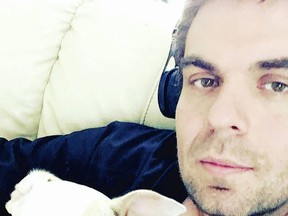There is no evidence that police did not follow their training to conduct traffic stops as they did, according to the Crown statement.

Article content
No charges have been approved against three RCMP officers in the shooting death nearly three years ago of Jared Lowndes, an Indigenous man from the Wet’suwe’ten First Nation in northwestern British Columbia.
The British Columbia Prosecutor’s Office made the announcement Tuesday afternoon after reviewing an investigation by the province’s Independent Investigation Bureau into the deadly shooting that took place at a Tim Hortons in Campbell River.
Advertisement 2
Article content
Article content
The IIO determined there were reasonable grounds to believe the officers may have committed offenses and submitted a report to the prosecution, but the Crown concluded that the available evidence does not meet its standard for assessing charges.
During the incident, RCMP placed a police dog on Lowndes’ vehicle after he pepper sprayed several officers. Lowndes stabbed and killed the dog with a large knife, refused commands to surrender and had the knife in his hands when he exited the vehicle and was shot by police, according to a statement from the service.
“The (BC Prosecutor’s Office) cannot prove beyond a reasonable doubt that the officers committed any crime in connection with the incident,” the statement said.
The decision not to lay charges comes just two weeks after the British Columbia Prosecutor’s Office stayed manslaughter charges against two RCMP officers in the 2017 killing in Prince George of Dale Culver, a Wet Nations Indigenous man. ‘suwet’en and Gitxsan in northern British Columbia.
Lowndes also had connections to the Xwemalhkwu First Nation on Vancouver Island through his daughters.
Article content
Advertisement 3
Article content
Both cases have attracted considerable attention among family members, First Nations leaders and civil rights advocates who criticize police use of force and de-escalation techniques.
In cases where the service decides not to press charges against officers, the reasons are detailed in a statement.
The Crown’s 11-page statement says Lowndes was detained around 5:30 a.m. on July 8, 2021 by an RCMP officer who discovered Lowndes was the subject of an arrest warrant for allegedly breaching an order. for a firearms crime. .
As the officer approached the driver’s window of the Audi, Lowndes quickly reversed, crashed into the police vehicle and accelerated.
Officers later saw and caught up with Lowndes at a Tim Hortons drive-thru, where officers attempted to restrain his car.
Lowndes was able to quickly reverse out of the drive-thru and collided with another vehicle while trying to exit the parking lot. When Lowndes attempted to return through the on-ramp lane, he was blocked by police vehicles. Several officers approached Lowndes with guns drawn and loudly instructed him to show his hands, the statement said.
Advertisement 4
Article content
As an officer approached the Audi, Lowndes sprayed a large amount of bear spray (pepper) at several officers and forced them to retreat. Lowndes tried to escape with his car but couldn’t.
One of the officers then picked up a police dog and put it into the Audi through the open driver’s side window. Lowndes used a large knife to stab the dog and kill it. The officer reached into the vehicle and was stabbed.
The officers shouted commands and deployed a Taser twice, but Lowndes used the knife to cut the wires of the Taser.
Lowndes continued yelling “shoot me, kill me” as he got out of the car. He had one foot on the ground and was still holding the knife when two officers fired almost simultaneously, the statement said.
One officer shot Lowndes twice in the back and the other officer’s shot missed. At the same time, another officer drove directly into the side of the car, likely running over Lowndes, who was on the ground.
The prosecution said it considered whether the police officers’ actions unnecessarily contributed to a dangerous situation that affected the reasonableness of the deployment of deadly force.
Advertisement 5
Article content
“There is no evidence that police did not follow their training to stop traffic the way they did, to approach the vehicle to make the arrest, or any other aspect of their response. “There is also nothing to suggest foreseeability that his decision-making would have led to the tragic consequences that occurred,” according to the statement.
Recommended by Editorial
-

Manslaughter charges stayed against two RCMP officers in 2017 death of Dale Culver
-

Policing in British Columbia: Are changes coming? Is the RCMP about to disappear?
Bookmark our website and support our journalism: Don’t miss the news you need to know – add VancouverSun.com and LaProvincia.com to your favorites and subscribe to our newsletters here.
You can also support our journalism by becoming a digital subscriber: for just $14 a month, you can get unlimited access to The Vancouver Sun, The Province, National Post and 13 other Canadian news sites. Support us by subscribing today: The Vancouver Sun | The province.
Article content


